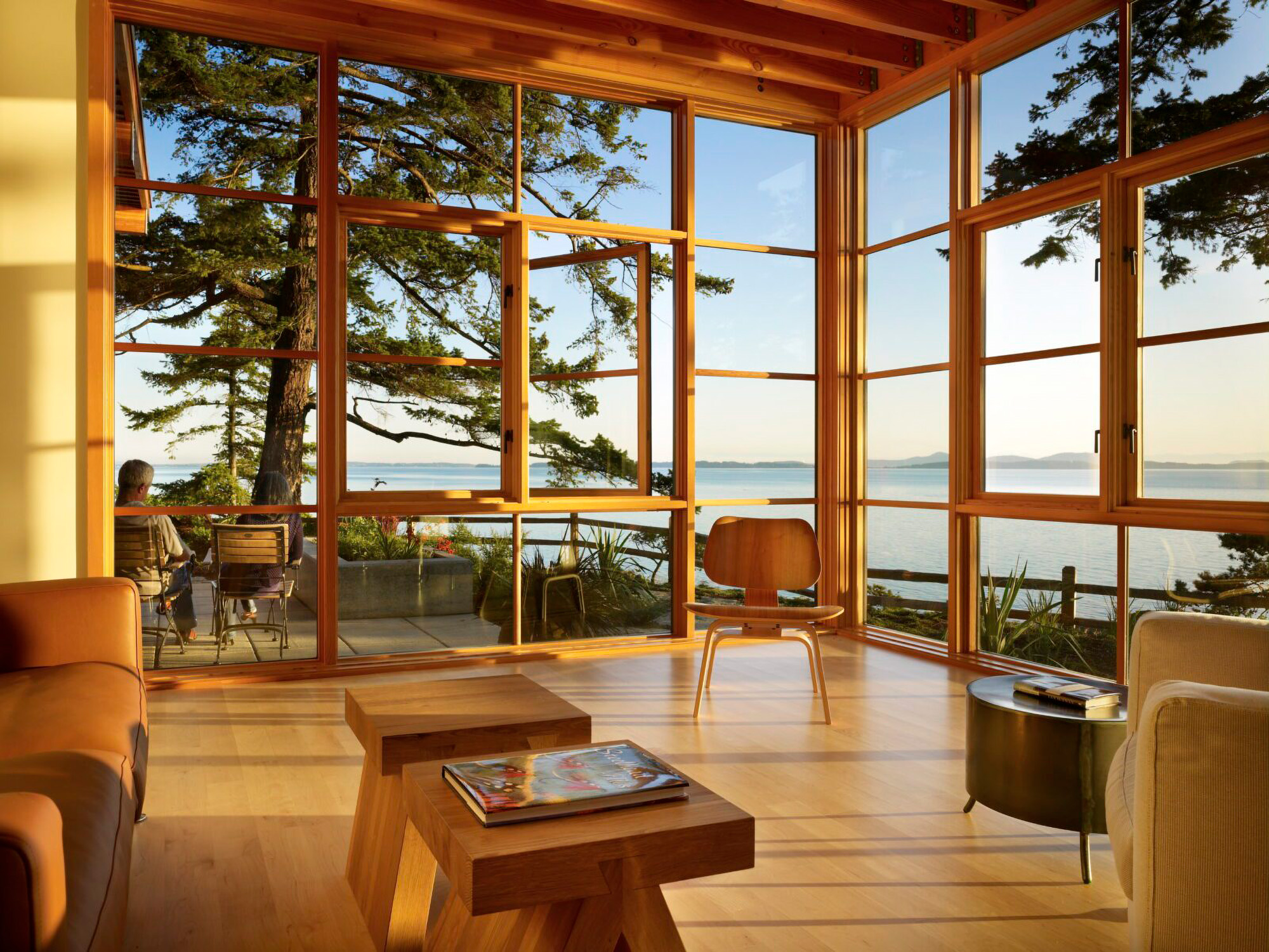We spend most of our lives inside, and the spaces we inhabit have the potential to greatly impact our health depending on the kinds of design decisions made. From the air we breathe, to the surfaces on which we rest our bodies, to the sensory connections we establish with the outside environment, there are countless opportunities for us as designers to promote wellness in our interior projects.
The following strategies are among what we at Miller Hull think are the most important, and when applied (especially all together), they can create spaces that fuel our minds as much as they support and protect our bodies.
Natural Light and Views
Maximizing natural light and integrating views of nature within interior spaces are essential strategies for promoting wellbeing and productivity. Natural light boosts mood, enhances alertness, and helps regulate circadian rhythms, contributing to better sleep patterns. Other design tactics such as large floor-to-ceiling windows, light-colored finishes, skylights, and interior glazing facilitate the penetration of daylight, creating brighter and more spacious environments. Incorporating views of nature further enhances the calming and uplifting atmosphere, fostering a holistic experience for occupants while promoting health and productivity.
Air Quality
Ensuring good indoor air quality is absolutely critical when designing interior spaces, so choosing low or no-VOC (volatile organic compound) materials such as paints and finishes is a necessary step. These selections minimize harmful emissions, prevent indoor air pollution, and reduce the risk of respiratory issues and allergies among occupants. Opting for advanced ventilation and air purification systems is also a recommended strategy for indoor air quality, removing pollutants, allergens, and odors from the air; and helping to control moisture and prevent mold growth.
Ergonomics
Creating comfort for people is of the utmost importance in any design project, and ergonomic furniture helps contribute to this kind of physical wellbeing. For example, chairs and desks that are adjustable encourage proper posture while reducing strain and discomfort for users. Layout can also be approached ergonomically by providing alternative types of spaces conducive for different types of studying, working, learning, and collaborating. This approach not only enhances the overall comfort and functionality of interior spaces but also supports productivity by planning spaces that can adapt to the varying needs and preferences of occupants.
Acoustic Comfort
The use of materials that are sound absorptive serves to mitigate noise pollution, which creates an environment that fosters tranquility and enhances concentration. Including such materials in finishes, furniture, and architectural structures helps to dampen sound reflections, reducing reverberation and minimizing disruptions from external sources or neighboring spaces. By considering acoustics, the privacy and comfort of a space are drastically enhanced, creating a peaceful environment that improves communication in spaces like educational institutions or healthcare facilities, and facilitates restful sleep in residential settings.
Color Psychology
Colors wield immense power in interior design, shaping not only the aesthetic appeal but also the functionality of the space. For example, using soft, natural hues like muted blues and greens will cultivate an atmosphere that communicates tranquility, an ideal ambiance in settings such as bedrooms and living areas. In educational environments, these calming tones might serve as the base color palette, complemented by brighter colors like yellow and orange to stimulate energy, inspire creativity, or indicate wayfinding. By strategically incorporating different vibrancies and hues, designers can create spaces that harness the psychological effects of color.
Flexible Spaces
Designed spaces that can adapt to different uses allowing users to change the environment to suit their needs, which contribute to overall well-being. When a space empowers its occupants to optimize their surroundings for different activities or technological capabilities, it fosters autonomy and control. In residences, flexible layouts accommodate diverse lifestyles, seamlessly transitioning between work and leisure. Similarly, in commercial environments, adaptable workstations promote collaboration and productivity. Public spaces benefit from flexibility by hosting various events and gatherings, enhancing inclusivity and community engagement. Additionally, when spaces have an eye towards the future and are capable of being reconfigured depending on new needs, standards, and occupant typology, they stand the test of time. Prioritizing flexibility in design not only enhances functionality but also creates spaces that align with the myriad and evolving ways that humans behave.
Healthy Materials
In prioritizing human health and environmental well-being, it’s essential to understand the toxicity concerns of materials, a commitment underscored by our support for evolving scientific data. Miller Hull’s pledge to remove red list chemicals from our projects reflects our dedication to proactive health-conscious practices. By eliminating substances known to pose risks to health and the environment, we prioritize the safety of occupants and ecosystems alike, aligning with sustainability principles and regulatory standards. Through ongoing research and collaboration, we aim to continually improve our practices, creating spaces that not only endure but also promote the health and well-being of all who inhabit them.
Just because we are inside doesn’t meant we should have to abandon our bond with the earth. Connecting people to nature while they are indoors enhances wellbeing and fosters a sense of harmony with the environment, ultimately creating spaces that humans are happy (and healthy) to return to, time and time again.
More from Author
Miller Hull | Sep 18, 2024
3 living buildings made by a living practice
Prompting humans to reexamine our relationship to the environment, architecture creates the opportunity for us to physically experience ideas of beauty, performance, and structure through the distinct lens of place.







